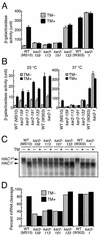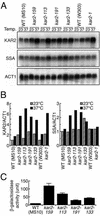Genetic evidence for a role of BiP/Kar2 that regulates Ire1 in response to accumulation of unfolded proteins
- PMID: 12808051
- PMCID: PMC194903
- DOI: 10.1091/mbc.e02-11-0708
Genetic evidence for a role of BiP/Kar2 that regulates Ire1 in response to accumulation of unfolded proteins
Abstract
In the unfolded protein response (UPR) signaling pathway, accumulation of unfolded proteins in the endoplasmic reticulum (ER) activates a transmembrane kinase/ribonuclease Ire1, which causes the transcriptional induction of ER-resident chaperones, including BiP/Kar2. It was previously hypothesized that BiP/Kar2 plays a direct role in the signaling mechanism. In this model, association of BiP/Kar2 with Ire1 represses the UPR pathway while under conditions of ER stress, BiP/Kar2 dissociation leads to activation. To test this model, we analyzed five temperature-sensitive alleles of the yeast KAR2 gene. When cells carrying a mutation in the Kar2 substrate-binding domain were incubated at the restrictive temperature, association of Kar2 to Ire1 was disrupted, and the UPR pathway was activated even in the absence of extrinsic ER stress. Conversely, cells carrying a mutation in the Kar2 ATPase domain, in which Kar2 poorly dissociated from Ire1 even in the presence of tunicamycin, a potent inducer of ER stress, were unable to activate the pathway. Our findings provide strong evidence in support of BiP/Kar2-dependent Ire1 regulation model and suggest that Ire1 associates with Kar2 as a chaperone substrate. We speculate that recognition of unfolded proteins is based on their competition with Ire1 for binding with BiP/Kar2.
Figures






Similar articles
-
BiP-bound and nonclustered mode of Ire1 evokes a weak but sustained unfolded protein response.Genes Cells. 2013 Apr;18(4):288-301. doi: 10.1111/gtc.12035. Epub 2013 Feb 6. Genes Cells. 2013. PMID: 23387983
-
Self-association and BiP dissociation are not sufficient for activation of the ER stress sensor Ire1.J Cell Sci. 2007 May 1;120(Pt 9):1681-8. doi: 10.1242/jcs.002808. J Cell Sci. 2007. PMID: 17452628
-
BiP binding to the ER-stress sensor Ire1 tunes the homeostatic behavior of the unfolded protein response.PLoS Biol. 2010 Jul 6;8(7):e1000415. doi: 10.1371/journal.pbio.1000415. PLoS Biol. 2010. PMID: 20625545 Free PMC article.
-
IRE1 and efferent signaling from the endoplasmic reticulum.J Cell Sci. 2000 Nov;113 Pt 21:3697-702. doi: 10.1242/jcs.113.21.3697. J Cell Sci. 2000. PMID: 11034898 Review.
-
The unfolded protein response (UPR) pathway in Cryptococcus.Virulence. 2014 Feb 15;5(2):341-50. doi: 10.4161/viru.26774. Epub 2013 Oct 18. Virulence. 2014. PMID: 24504058 Free PMC article. Review.
Cited by
-
The essential biology of the endoplasmic reticulum stress response for structural and computational biologists.Comput Struct Biotechnol J. 2013 Sep 3;6:e201303010. doi: 10.5936/csbj.201303010. eCollection 2013. Comput Struct Biotechnol J. 2013. PMID: 24688718 Free PMC article. Review.
-
Dynamics of ER stress-induced gene regulation in plants.Nat Rev Genet. 2024 Jul;25(7):513-525. doi: 10.1038/s41576-024-00710-4. Epub 2024 Mar 18. Nat Rev Genet. 2024. PMID: 38499769 Free PMC article. Review.
-
BiP: Master Regulator of the Unfolded Protein Response and Crucial Factor in Flavivirus Biology .Yale J Biol Med. 2017 Jun 23;90(2):291-300. eCollection 2017 Jun. Yale J Biol Med. 2017. PMID: 28656015 Free PMC article. Review.
-
TorsinA folding and N-linked glycosylation are sensitive to redox homeostasis.Biochim Biophys Acta Mol Cell Res. 2021 Aug;1868(9):119073. doi: 10.1016/j.bbamcr.2021.119073. Epub 2021 May 29. Biochim Biophys Acta Mol Cell Res. 2021. PMID: 34062155 Free PMC article.
-
Endoplasmic reticulum stress alters myelin associated protein expression and extracellular vesicle composition in human oligodendrocytes.Front Mol Biosci. 2024 Oct 1;11:1432945. doi: 10.3389/fmolb.2024.1432945. eCollection 2024. Front Mol Biosci. 2024. PMID: 39411401 Free PMC article.
References
-
- Bertolotti, A., Zhang, Y., Hendershot, L.M., Harding, H.P., and Ron, D. (2000). Dynamic interaction of BiP and ER stress transducers in the unfolded-protein response. Nat. Cell Biol. 2, 326-332. - PubMed
-
- Brodsky, J.L., and Rose, M.D. (1997). Saccharomyces cerevisiae Kar2p. In: Molecular Chaperones and Protein-Folding Catalysts, ed. M.J. Gething, New York: Oxford University Press, 33-36.
-
- Brodsky, J.L., Werner, E.D., Dubas, M.E., Goeckeler, J.L., Kruse, K.B., and McCracken, A.A. (1999). The requirement for molecular chaperones during endoplasmic reticulum-associated protein degradation demonstrates that protein export and import are mechanistically distinct. J. Biol. Chem. 274, 3453-3460. - PubMed
-
- Bukau, B., and Horwich, A.L. (1998). The Hsp70 and Hsp60 chaperone machines. Cell 92, 351-366. - PubMed
Publication types
MeSH terms
Substances
Grants and funding
LinkOut - more resources
Full Text Sources
Other Literature Sources
Molecular Biology Databases

